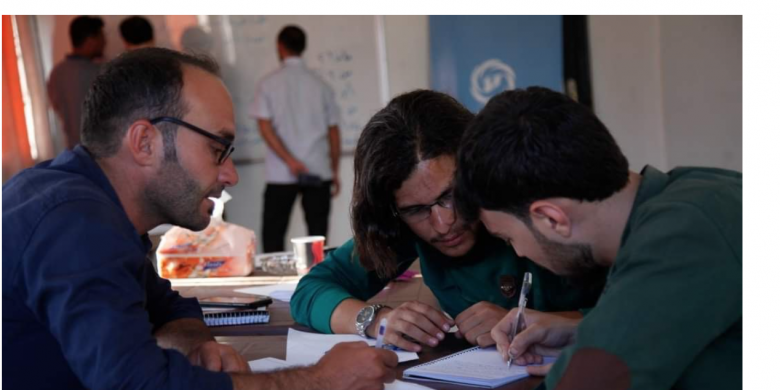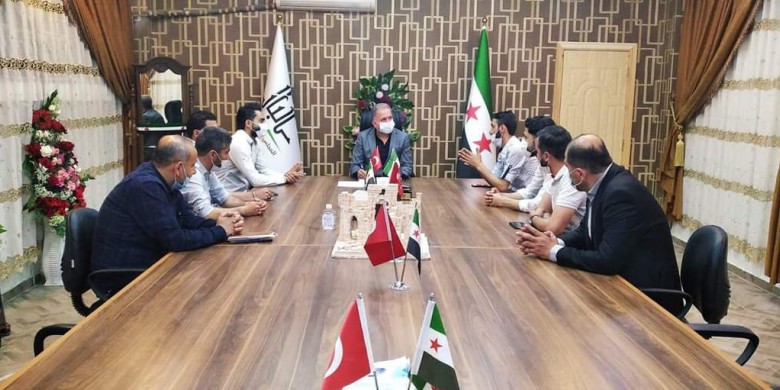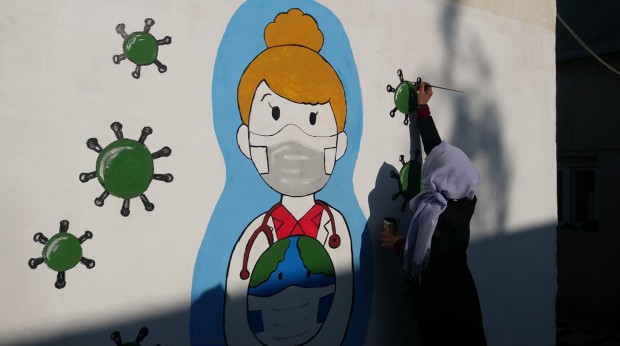
Pens Against Guns
“Local Voices at a Crossroads” is an article series in which local actors of everyday peace share their insights into the fragilities and resilience of their societies in the face of conflict. Grassroots societies lie at the crossroads between local realities and national peacebuilding policies and practices. The series therefore aims to accelerate action at the local level by strengthening the voices of civil society at the policy level. “Local Voices at a Crossroads” is hosted by the Civil Society Platform for Peacebuilding and Statebuilding (CSPPS) and emerged from a collaboration with the Political Settlements Research Programme (PSRP*), based at the University of Edinburgh.
For our third contribution on the role of Syrian youth in local peacebuilding, we look at the media as one of the fields most impacted by the ten-year-long conflict. The 3rd of May 2021 marked World Press Freedom Day, acknowledging that responsible journalism and freedom of the press are crucial for building peace. Yet, according to Reporters Without Borders, Syria has witnessed the deadliest-ever conflict for the media and the country remains “an unbearable environment” for journalists who are the targets of intimidations, arrest, assault, and killing by all conflict actors.
Citizen journalism and a new media landscape
Before the outbreak of the conflict in 2011, the 40-year monopoly of the ruling Ba’ath party over the Syrian media had only been broken by the arrival in power of Bashar al-Assad, who allowed private publications under the tight control of the Ministry of Information. The peaceful demonstrations and their violent repression by the Syrian regime were documented by thousands of civilians using their phones to cover the events and to record human rights violations. Syria thus became “the first social media war”. However, the emergence of citizen journalists with no knowledge of practices and ethical standards negatively impacted the media field, which became less professional and less regulated. It also put citizens at risk, as their videos were used by several conflict actors to justify their arrest and detention.
"Words and the pen are as powerful as guns. In the past, Syria was destroyed, and human rights were violated with impunity because of the very absence of media to cover these events, to raise awareness, and to offer different opinions than that of the Syrian regime"
When the Syrian regime regained control over most of the territory, it also accelerated the crackdown on alternative voices by passing a new anti-cybercrime bill and implementing an “internet rationing” system from 2018 onwards. Across the country, the vice tightened around media organisations and journalists. In opposition-held areas, which remain the beating heart of the revolution, the de-facto governments failed to support the creation of a new media landscape and foster freedom of the press. External media in support of the protests against the Syrian regime dominate media coverage, while local media remain deeply politicised and affiliated to conflict actors. Local media also lack financial independence and logistic capabilities. In this environment, “neutral” media face the most pressures and challenges, while journalists are confronted with multiple threats, as reminded by the assassination of Hussein Khattab in December 2020. The prominent media activist was assassinated by “unknown gunmen” while preparing a photo report on COVID-19 in al-Bab, 45 kilometres in the northeast of Aleppo. The assassination triggered a wave of public outrage in northern Syria and abroad.

Besides “street journalism”, professionals, media activists and members of the opposition also created tens of “independent” media outlets, in order to provide alternatives to the information apparatus of the Syrian regime. By 2016, an estimated 196 independent media channels were operating across languages and political lines inside and beyond Syrian borders. But after ten years of conflict, only a few of these new media channels survived, and most of them resorted to online platforms. This is the case of the weekly newspaper Enab Baladi and satellite television and multimedia Orient News, established in the United Arab Emirates by Syrian entrepreneur Ghassan Aboud.
Opening youths’ horizon
The many challenges facing the media field in Syria, including in the areas outside the control of the Syrian government, make the future of journalism uncertain. Yet, the media field remains attractive for youth. After 2011, many young people expressed the wish to gain skills in a range of competencies such as web design, photography, and editing, in order to report on conflict-related events. The craze for (social) media reporting opened opportunities to reform the field by offering professional training to youth and encouraging good practices. Besides this, the strong presence in Syria of international media organisations and staff offer additional prospects to consolidate skills and gain complementary experience for young professionals.
Mariam is a 19-year-old student at the Media Institute in Azaz, after having been displaced from Atarib, a city located 25 kilometres west of Aleppo. She wants to be a journalist to shed light on societal issues experienced by marginalised groups in northwest Syria and to echo a popular voice devoid of political agenda. Mariam is confident that journalism “opens youths’ horizons and offers opportunities to express our needs and concerns and to be represented in the public debate”. In her opinion, the main challenge facing aspiring journalists in opposition-held areas is to promote neutral accounts of local dynamics: “Young journalists today face a dilemma: they can either adhere to the ethical principle of professional journalism and stay neutral, or they can put their feelings first, and let trauma and violence speak”.
"The media is a double-edged sword that can fuel conflicts as much as promote peace, depending on the discourse it circulates. Media can heal or destroy; it can unite or disperse"
On the other hand, five decades of tight control and repression against the media has resulted in the absence of qualified teachers and outdated curricula that does not include any reference to recent developments in the media field such as online platforms. But young journalists can rely on various sources of support, as explained by Abdalgader Haj Othman, the director of Azaz Media Office: “We support the creation of volunteer teams in northern Aleppo governorate by publishing the pieces of non-professional young journalists, helping them to reach grassroots communities and official institutions and to secure work permits. We also recruit university students so that they can gain practical experience”. According to Abdalgader, support also lies in the commitment of professional bodies to cover local dynamics beyond the politics of the conflict, such as cultural activities and university events that contribute to enhancing the role of youth in society.

The need to institutionalise journalism… and peace
During our investigation, we met with Mohammad, a producer for a regional media agency covering Syria. For him, media is a key source of resistance to oppression: “Words and the pen are as powerful as guns. In the past, Syria was destroyed, and human rights were violated with impunity because of the very absence of media to cover these events, to raise awareness, and to offer different opinions than that of the Syrian regime”. But like any weapon, the media needs to be carefully calibrated: “The media is a double-edged sword that can fuel conflicts as much as promote peace, depending on the discourse it circulates. Media can heal or destroy; it can unite or disperse”, warns Mohammad. In an attempt to turn media into a weapon for positive social change, Azaz Media Center created a communication center that provides a platform for dialogue and mediation of social conflicts, notably between displaced and host communities. According to the people we talked to, many more media initiatives can foster a culture of tolerance and peaceful coexistence in Syria, such as competitions over blogs and pictures carrying a message of peace.
The chaotic explosion of media after 2011 and the dangers facing journalists across the country led to the realisation that the field needed greater institutionalisation. At the time of writing, there is no Ministry of Information in the de-facto Interim government, nor laws to regulate media practices and protect journalists in the opposition-held areas. In an attempt to fill this vacuum, in November 2017, journalists and media activists created the Media Union of Syrian Journalists in Aleppo and its Countryside with the mission to agree on “a code of honour, principles of work, and ethics for dealing with that activity”. Similar unions exist across Syria, but none has official status. In November 2020, four unions based in Syria and Turkey established an umbrella organisation, Syria Media Council, to protect journalists' rights and freedom of expression. While some voices suggested that the new Council may intend to cover up internal divides within the Syrian Journalists Association, others raised questions on its ability to effectively bring about a positive change in the media field in Syria.

There is still a long way to go for Syrian media to become effective instruments of peace and represent a platform of expression for all shades of Syrian opinions. The determination of young Syrians like Miriam and the commitment of local media agencies such as Azaz Media Center are encouraging steps forward, and strongly advocate for the engagement of the media sector as a powerful, non-violent alternative to conflict and a tool of inclusion.
_________________________________________________
Raise your voice! Contact us to share your or others’ experiences of vulnerability and resilience to conflict and efforts for peace.
Article written by Juline Beaujouan, Eyas Ghreiz and Abdulah El hafi
Juline Beaujouan is a Research Associate with the Political Settlements Research Programme (PSRP), based at the University of Edinburgh, where she researches local conflict management and trust-building in Lebanon, Iraq and Syria. Juline received her Ph.D from Durham University where she was awarded the al-Sabah doctoral fellowship and acted as a member of the AHRC’s Open World Research Initiative (OWRI). Juline is the co-editor and contributor to the volume Syrian Crisis, Syrian Refugees - Voices from Jordan and Lebanon, and co-author of Islam, IS and the Fragmented State: The Challenges of Political Islam in the MENA Region.
Eyas Ghreiz is a researcher and consultant in areas of human rights and development. Ghreiz is also a Master student in International Development, specialising in conflict, security and development, at the University of Birmingham, UK. Ghreiz has over eight years of working experience with international NGOs, and UN bodies in Jordan, Syria, Turkey and Yemen. He has published several articles in both Arabic and English and contributed to the book Syrian Crisis, Syrian Refugees: Voices from Jordan and Lebanon, published by Palgrave Macmillan in both English and Turkish, and will be published in Arabic soon.
Abdulah El hafi co-founded and managed the Unified Relief Office in Eastern Ghouta and sat on the board of directors for two years. In 2013, he was a founding member of the Civil Defense in Eastern Ghouta in Rif Damascus. From 2014 to 2019, Abdulah worked as a coordinator and field manager for several programs funded by the British DFID and USAID. He also delivers trainings in the field of good governance and capacity building for several local organizations, teams and councils in Rif Damascus, Idlib, and northern Aleppo governorates. Currently, Abdulah is working as the manager of the Local Administrative Councils Unit (LACU) Syria Office.
*The Political Settlements Research Programme is a partner of the Covid Collective. The Collective brings together the expertise of UK and Southern-based research partner organisations and offers a rapid social science research response to inform decision-making on some of the most pressing Covid-19 related development challenges. The PSRP and Covid Collective are supported by the UK FCDO.

